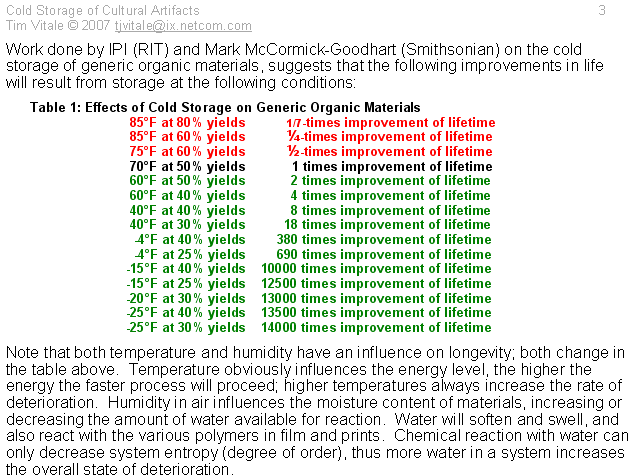Storage of Videotape |
Cold Storage of Cultural Artifacts by Tim Vitale, revised June 2009
History, Science and Storage of Cellulose Acetate Film Base by Tim Vitale, revised June 2009 Includes information on video tape that uses cellulose acetate carrier as part of the tape. Cold storage is the preferred solution, but at above freezing (35-40°F and above) as opposed to film, where colder is better. |
Link to AMIA "Video Preservation Handbook" (2002) by Jim Wheeler on the AMIA (Association of Moving Image Archivist) website. |
| Link to IPI (Image Permanence Institute) report on magnetic tape can be found online in their final report too the NEH: The Preservation of Magnetic Tape Collections: A Perspective, 2006, by Jean-Louis Bigourdan, James M. Reilly, Karen Santoro, Gene Salesin. |
| Link to A 1995 report on videotape by John Van Bogart: Magnetic Tape Storage and Handling, A Guide for Libraries and Archives. |
| Link to AMIA - Fact Sheet 8 - Environmental Conditions, (p 15) in their Videotape Preservation Fact Sheets series written by Jim Wheeler and edited by Hannah Frost (2003-4). |
Conditions for Use and Storage of Videotape The common recommenced range for working with all cultural material is 70°F +/- 10°F and 50% RH +/- 10% RH. If possible, working at lower temperatures and relative humidity is desirable. Daily storage (on the shelf) at 85°F and 60% RH will lower permanence to 25% of the recommended conditions, see Table 1 below.
Cool Storage of Videotape Cold storage of the original videotape at the commonly recommended conditions, will prolong its life 2-8 times, depending on its current state of preservation. At the end of this period (20-100 years), playback equipment probably won't be readily available.
Conundrum of Videotape Cold Storage. Practically speaking, storage at colder or dryer conditions won't provide greater permanence, even though the physical videotape would be playable if the equipment were available. This is the unfortunate Conundrum of Videotape Cold Storage.
Recommend Cool Storage Conditions Storage at 38-50°F and 25-40%RH is the common recommendation. The use of sealed polyethylene bags in a refrigerator set to 40-45°F would be an excellent solution. It would be desirable (but not critical) to lower the relative humidity (moisture content) of the videotapes, to 25-40% RH, in a sealed cabinet (or room) using a dehumidifier with good controls, before sealing the videotapes in their storage bags.
The sealed bag (two thick ZipLoc bags, or Metal-Edge Freezer Kits) allows the artifact maintain its moisture content, when the temperature is lowered and then raised, after being pulled from cold storage for use. The sealed bag must also contains a few layers good quality cellulose to act as a moisture sink, such as museum quality matboard, or acid-free paper. The sealed bag must go through a 2-8 hour warm up period.
Details on Cold Storage can be found in a PDF Cold Storage of Cultural Artifacts (updated 2009).
The following data table shows the generic improvement of artifact lifetime based on temperature and humidity (RH). Don't forget to allow for the current state when calculating the predicted lifetime. In the IPI 1998 report referenced above they suggest that there is no way, other than age, to predict the condition of historic videotapes.
|
 |
